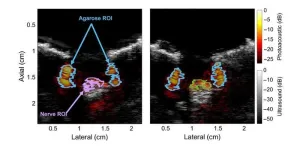(Press-News.org) Invasive medical procedures, such as surgery requiring local anesthesia, often involve the risk of nerve injury. During operation, surgeons may accidentally cut, stretch, or compress nerves, especially when mistaking them for some other tissue. This can lead to long-lasting symptoms in the patient, including sensory and motor problems. Similarly, patients receiving nerve blockades or other types of anesthesia can suffer from nerve damage if the needle is not placed at the correct distance from the targeted peripheral nerve.
Consequently, researchers have been trying to develop medical imaging techniques to mitigate the risk of nerve damage. For instance, ultrasound and magnetic resonance imaging (MRI) can help a surgeon pinpoint the location of the nerves during a procedure. However, it is challenging to tell the nerves apart from surrounding tissue in ultrasound images, while MRI is expensive and time-consuming.
In this regard, there is a promising alternative approach known as multispectral photoacoustic imaging. A noninvasive technique, photoacoustic imaging combines light and sound waves to create detailed images of tissues and structures in the body. Essentially, the target region is first illuminatedwith pulsed light, causing it to heat up slightly. This, in turn, causes the tissues to expand, sending out ultrasonic waves that can be picked up by an ultrasound detector.
A research team from Johns Hopkins University recently conducted a study in which they thoroughly characterized the absorption and photoacoustic profiles of nerve tissue across the near-infrared (NIR) spectrum. Their work, published in the Journal of Biomedical Optics, was led by Dr. Muyinatu A. Lediju Bell, John C. Malone Associate Professor and PULSE Lab Director at Johns Hopkins University.
One of the main objectives of their study was to determine the ideal wavelengths for identifying nerve tissue in photoacoustic images. The researchers hypothesized that the wavelengths from 1630–1850 nm, which reside within the NIR-III optical window, would be the optimal range for nerve visualization, since the lipids found in the myelin sheath of neurons have a characteristic absorption peak in this range.
To test this hypothesis, they performed detailed optical absorption measurements on peripheral nerve samples obtained from swines. They observed an absorbance peak at 1210 nm, which fell in the NIR-II range. However, such an absorption peak is also present in other types of lipids. In contrast, when the contribution of water was subtracted from the absorbance spectrum, nerve tissue exhibited a unique peak at 1725 nm in the NIR-III range.
Additionally, the researchers conducted photoacoustic measurements on the peripheral nerves of live swine using a custom imaging setup. These experiments further confirmed the hypothesis that the peak in the NIR-III band can be effectively leveraged to differentiate lipid-rich nerve tissue from other types of tissues and materials containing water or that are lipid-deficient. Satisfied with the results, Bell remarks: “Our work is the first to characterize the optical absorbance spectra of fresh swine nerve samples using a wide spectrum of wavelengths, as well as the first to demonstrate in-vivo visualization of healthy and regenerated swine nerves with multispectral photoacoustic imaging in the NIR-III window.”
Overall, these findings could motivate scientists to further explore the potential of photoacoustic imaging. Moreover, the characterization of the optical absorbance profile of nerve tissue could help improve nerve detection and segmentation techniques when using other optical imaging modalities.
“Our results highlight the clinical promise of multispectral photoacoustic imaging as an intraoperative technique for determining the presence of myelinated nerves or preventing nerve injury during medical interventions, with possible implications for other optics-based technologies. Our contributions thus successfully establish a new scientific foundation for the biomedical optics community,” concludes Bell.
For details, read the Gold Open Access article by M. Graham et al., “Optical absorption spectra and corresponding in vivo photoacoustic visualization of exposed peripheral nerves,” J. Biomed. Opt. 28(9), 097001 (2023), doi 10.1117/1.JBO.28.9.097001.
END
Visualizing nerves with photoacoustic imaging
Scientists investigate the unique absorption spectra of myelinated nerves as a way to visualize and differentiate them from their surroundings
2023-09-05
ELSE PRESS RELEASES FROM THIS DATE:
Study of “revolving door” in Washington shows one-third of HHS appointees leave for industry jobs
2023-09-05
LOS ANGELES – Almost one-third of government appointees to the Department of Health and Human Services (HHS) leave to take jobs in private industry, according to a study by the USC Schaeffer Center for Health Policy & Economics and Harvard University.
The study, published in Health Affairs, is the first to quantify the personnel movement between health-care industries and the government agencies that regulate them, according to the authors. Although there are understandable reasons for people to move between the public and private sectors, the study notes that such a revolving door could make government agencies more vulnerable to pro-industry bias.
“Laws passed ...
DOACs reduce dementia risk in Asian AFib patients compared to traditional blood thinners
2023-09-05
The use of direct oral anticoagulants (DOACs) was associated with a reduction in dementia risk compared to traditional blood thinners—like warfarin—in atrial fibrillation patients, particularly in Asian patients. According to a study published today in JACC: Asia, this benefit may reverse with increased age and necessitates further follow-up study.
“Asian patients are more likely to be sensitive to vitamin K antagonism, which puts them at high risk for bleeding events, contributing to dementia development ...
New research sheds light on origins of social behaviors
2023-09-05
ITHACA, N.Y. – Male fruit flies don’t usually like each other. Socially, they reject their fellow males and zero in on the females they discern via chemical receptors – or so scientists thought.
New research from Cornell University biologists suggests the fruit fly’s visual system, not just chemical receptors, are deeply involved with their social behaviors. The work sheds light on the possible origin of differences in human social behaviors, such as those seen in people with bipolar disorder ...
New Chagas research unravels decades-long mystery of how the tropical disease progresses
2023-09-05
New research from Tulane University may shed light on how parasite strain diversity can impact Chagas disease progression and severity.
Chagas, a lesser-known and studied tropical disease, is caused by Trypanosoma cruzi parasites, which are transmitted by kissing bugs. In the Americas, the disease affects 6 million people in 21 countries, with approximately 30,000 new cases each year. While most infected patients remain asymptomatic, about 20-40 percent of those infected will develop chronic heart disease ...
Electrifying heavy-duty vehicles could reduce environmental inequalities
2023-09-05
New simulations model traffic-related air pollution over the region surrounding Chicago, North America’s largest freight hub
In the simulations, the researchers modeled a scenario in which 30% of current on-road heavy-duty vehicles (HDVs) were replaced by electric HDVs
Electrifying HDVs would substantially reduce air pollution and save hundreds of lives annually in the region, with particularly large health benefits in predominantly Black, Hispanic and Latinx communities
The region also would save nearly $6 billion annually in avoided ...
Large Kaiser Permanente study could lead to better management for patients with aortic stenosis
2023-09-05
The diagnosed severity of aortic stenosis strongly correlates with clinical outcomes, new Kaiser Permanente research shows. But the study also suggests that fine-tuning physician assessment of those patients with moderate aortic stenosis could help improve outcomes and better determine which patients might benefit from surgery.
The study found that patients diagnosed with moderate aortic stenosis have outcomes most similar to those categorized with mild aortic stenosis while only those with moderate-to-severe aortic stenosis had outcomes similar to those with ...
Landmark NIH grant awarded to School of Nursing and Health Studies
2023-09-05
The University of Miami School of Nursing and Health Studies (SONHS) has been awarded an unprecedented $23.57 million grant from the National Institutes of Health (NIH) to join the Environmental influences on Child Health Outcomes (ECHO) Program.
The interdisciplinary grant, the largest award to date in the Coral Gables Campus’ history, is funding an ambitious project spearheaded by Hudson Santos, RN, PhD, FABMR, FAAN, the lead Principal Investigator and Vice Dean for Research Affairs, with Professor Michael Paidas, MD, chair of the University of Miami Miller School of Medicines Department of Obstetrics, ...
Study reveals disparities within NHS leadership
2023-09-05
New research shows that Allied Health Professions (AHPs) are significantly underrepresented in senior leadership roles despite being the third largest workforce in the NHS.
Ranging from paramedics to podiatrists, the AHPs encompass various healthcare disciplines, constituting a workforce of 185,000 within the NHS.
However AHPs have historically been underrepresented in strategic leadership positions, often occupied by medical professionals. To address this, NHS England advocated for the establishment of a Chief AHP role in every Trust to harness the untapped potential of this workforce and increase diversity in leadership ...
Eating a vegan diet could reduce grocery bill 16%, a savings of more than $500 a year, finds new research
2023-09-05
WASHINGTON, D.C.—Food costs decrease 16% on a low-fat vegan diet, a savings of more than $500 a year, compared to a diet that includes meat, dairy, and other animal products, according to a new analysis from the Physicians Committee for Responsible Medicine published in JAMA Network Open.
“We knew that a vegan diet significantly reduces your risk of conditions like heart disease, diabetes, and obesity—and now we have proof that opting for beans instead of beef will also lead to significant savings on your grocery bill,” says study co-author Hana Kahleova, ...
Positive body image linked to better life satisfaction
2023-09-05
Having more positive body image is strongly associated with better psychological wellbeing and life satisfaction, according to a new study led by Anglia Ruskin University (ARU) in England.
Published in the journal Body Image, the research is one of the largest studies ever conducted on the topic of body image, involving 56,968 participants in 65 nations.
The research was focused on ‘body appreciation’, defined as “accepting, holding favourable opinions toward, and respecting the body, while also rejecting media-promoted appearance ...
LAST 30 PRESS RELEASES:
Short-circuiting pancreatic cancer
Groundbreaking mapping: how many ghost particles all the Milky Way’s stars send towards Earth
JBNU researchers propose hierarchical porous copper nanosheet-based triboelectric nanogenerators
A high-protein diet can defeat cholera infection
A more accurate way of calculating the value of a healthy year of life
What causes some people’s gut microbes to produce high alcohol levels?
Global study reveals widespread burning of plastic for heating and cooking
MIT study shows pills that communicate from the stomach could improve medication adherence
Searching for the centromere: diversity in pathways key for cell division
Behind nature’s blueprints
Researchers search for why some people’s gut microbes produce high alcohol levels
Researchers find promising new way to boost the immune response to cancer
Coffee as a staining agent substitute in electron microscopy
Revealing the diversity of olfactory receptors in hagfish and its implications for early vertebrate evolution
Development of an ultrasonic sensor capable of cuffless, non-invasive blood pressure measurement
Longer treatment with medications for opioid use disorder is associated with greater probability of survival
Strategy over morality can help conservation campaigns reduce ivory demand, research shows
Rising temperatures reshape microbial carbon cycling during animal carcass decomposition in water
Achieving ultra-low-power explosive jumps via locust bio-hybrid muscle actuators
Plant-derived phenolic acids revive the power of tetracycline against drug-resistant bacteria
Cooperation: A costly affair in bacterial social behaviour?
Viruses in wastewater: Silent drivers of pollution removal and antibiotic resistance
Sub-iethal water disinfection may accelerate the spread of antibiotic resistance
Three in four new Australian moms struggle with body image
Post-stroke injection protects the brain in preclinical study
Cardiovascular risk score predicts multiple eye diseases
Health: estimated one in ten British adults used or interested in GLP-1 medications for weight loss
Exercise to treat depression yields similar results to therapy
Whooping cough vaccination for pregnant women strengthens babies’ immune system
Dramatic decline in new cases of orphanhood in Uganda driven by HIV treatment and prevention programs
[Press-News.org] Visualizing nerves with photoacoustic imagingScientists investigate the unique absorption spectra of myelinated nerves as a way to visualize and differentiate them from their surroundings

